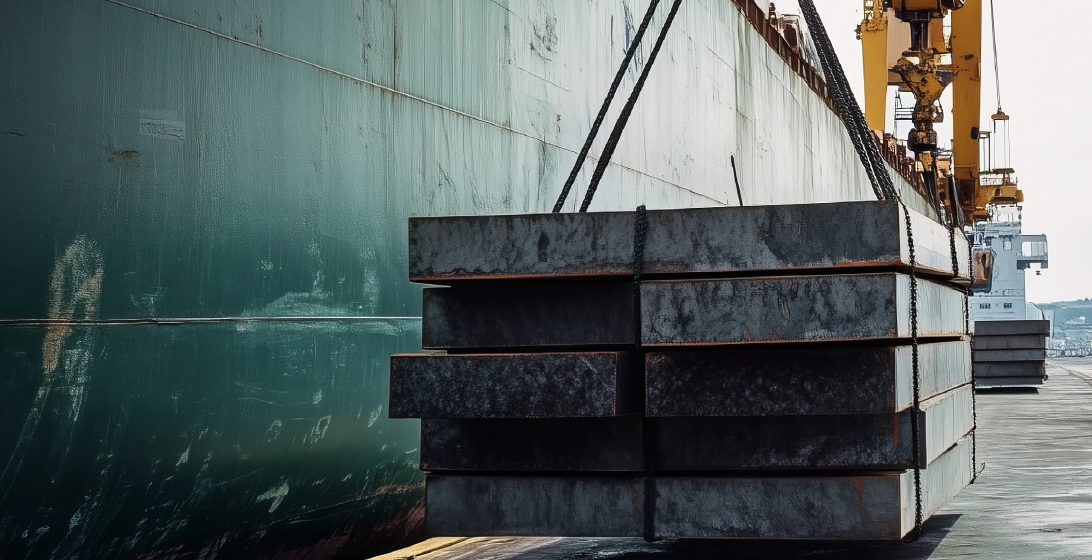New bold policies needed to tackle steel imports and ensure Government sees return on investments

7 October 2024
Today, UK Steel is launching a report showing how global excess steel production capacity, driven by non-market forces, poses an existential risk to the UK steel industry and has the potential to cancel out all other efforts and investments in decarbonisation.
Global steel excess capacity in 2023 was estimated at 543 million tonnes (Mt), more than 70 times the size of the UK market. Southeast Asia and the Middle East have seen rapid expansions of steelmaking, largely state-funded and mostly for high-emission blast furnaces which do not reflect domestic demand levels. Steel demand in China, the world’s biggest steelmaker, is also weakening, causing supply to spill over into other markets and dampen steel prices. China is expected to export 100Mt of steel during this year alone. This could meet the entirety of the UK’s steel demand for 13 years. Already the import share in the UK has jumped to a shocking 68% so far in 2024, from 60% in 2023 and 55% in 2022. The last time these levels of Chinese exports were seen, several UK steel plants were forced to close and thousands of jobs were lost.
UK Steel argues that while the UK Government is investing seriously in building the UK steel industry, addressing excess capacity and fair competition should be a fundamental element of the upcoming Steel Strategy. Steel safeguards, which have been shielding the UK sector from trade diversion, will have to expire in 2026 due to WTO rules. Action must be taken urgently ahead of existing protections lapsing in 21 months’ time. US Section 232 tariffs, which first triggered the introduction of safeguards, are here to stay. Countries around the world, including the EU, are stepping up their trade defence, and protectionism is on the rise. This means even greater trade diversion is likely to be directed to any markets left exposed. Trade policy in the UK must go further than it has before if industry is to have a fair chance of competing for market share.
UK Steel makes four recommendations to address the impacts of global overcapacity on the UK industry:
- Explore trade policy options, including ones that make use of WTO exceptions, in the context of actions taken by other WTO members.
- Review the UK trade remedies framework to make it more accessible to industry.
- Play an active role in international initiatives such as potential Global Arrangement on Sustainable Steel and Aluminium currently being negotiated between the US and EU.
- Strengthen carbon leakage and public procurement policies to counter the impact of excess capacity on UK producer market share.
UK Steel Director General, Gareth Stace, said:
“Rising global excess capacity driven and sustained by non-market forces is one of the biggest challenges of our time for the global steel industry. It has the potential to redraw the map of global steelmaking as there is no longer fair competition. A raft of distortive subsidies is leading to oversupply which is met with rising protectionism and trade diversion.
“Failing to tackle the issue head-on could see British steelmakers continue to lose market share and mean that investments in decarbonisation are all for naught. So far steel safeguards have offered a necessary shield but their expiry in 2026 could see industry faced with a cliff edge.
“We invite Government to be bold, show leadership, and balance international obligations with the national interest. Now is the time to create a fair and competitive trade landscape for the UK steel industry that will underpin UK jobs, economic resilience, and decarbonisation.”
Key figures:
- Measured as the gap between global capacity and crude steel production, global excess capacity in 2023 was estimated at 543 million tonnes (Mt), which is over 70 times the size of the UK market.
- Capacity expansions in Southeast Asia and the Middle East are continuing at an alarming rate – these are largely state-funded, mostly for high-emission blast furnaces, and often do not correspond to domestic demand trends.
- Over two thirds of steelmaking capacity is in countries that have Net Zero targets later than 2060 or none at all.
- Carbon-intensive blast furnaces account for more than 74% of capacity additions in Asia; 89% of blast furnace energy input globally comes from coal.
- Steel demand is weakening in China, causing rising oversupply, dampening steel prices and spilling over into other markets. Exports from China this year are expected to reach 100Mt, the highest since 2016.
- Chinese exports increased by 20% in the first half of 2024, following a 38% increase in 2023.
- UK imports have increased by 17% year-on-year so far in 2024 amid weak demand.
- The UK import share has jumped to 68% over Jan-May 2024, from 60% 2023 and 55% 2022.
- The sharpest import increases have come from non-EU sources, mainly India, Vietnam, China, South Korea, Turkey and Algeria. Importantly, these are also countries that have seen significant increases in imports from China or are within China’s top ten exporting destinations.
- There are a total of 666 active trade remedies measures on steel globally as of 2023 and protectionism is on the rise. Other countries, including the US, the EU and Canada are stepping up their trade defence.
- The US introduced 25% tariffs under Section 232 back in 2018 in response to global overcapacity and oversupply coming out of China. This triggered the introduction of steel safeguards setting tariff-rate quotas in the EU and UK, but these can only be in place for a maximum of eight years under WTO law.